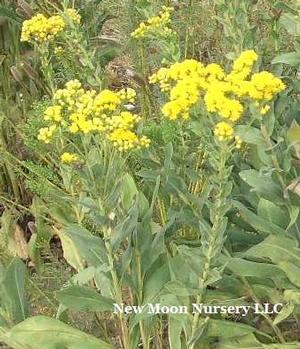Printed at http://www.newmoonnursery.com/index.cfm/
Solidago rigida
Stiff goldenrod
Native to North America
FIRST IMPRESSIONS: Solidago rigida is an upright unbranched perennial wildflower with sturdy pubescent stems. Leaves are lance shaped or elliptical with a bluntly rounded tip. In late summer and autumn, attractive golden-yellow flat topped flower clusters appear. Plants are tough and adaptable, prospering in sunny moist or wet sites.
HABITAT & HARDINESS: Solidago rigida occurs in Ontario and in the eastern and central United States from Massachusetts to South Carolina and west to Minnesota, Nebraska, Kansas, Oklahoma and Texas. The species is most common in prairie regions.
Indigenous plants occur in tallgrass and mixed grass prairies, Blackland prairies, open woods, savannas, limestone glades, meadows, rock outcrops, thickets, old fields, roadsides, disturbed prairie remnants and pastures. This species tolerates fire and over-grazing and seems to prefer sites with calcareous soils.
Plants are hardy from USDA Zones 3-9.
PLANT DESCRIPTION: Solidago rigida is an unbranched perennial with stems that are covered in fine white hairs.
The semi-evergreen basal leaves have petioles and are up to 10” long and 5” wide. The pubescent blades are rough to the touch and lanceolate, oblong or oval with bluntly rounded tips. They are soft gray-green with smooth or toothed margins and a wedge shaped base. They sometimes develop red fall color.
The stem leaves are alternate, much smaller and sessile.
The central stem is topped by a flat topped corymb-like flower cluster. The entire inflorescence is 2-10” across and is composed of many flowerheads. The heads are large by goldenrod standards and are composed of 7-14 ray florets surrounding 7-35 disc florets.
The florets mature into small angular achenes crowned by tufts of hair.
Plants grow 2-5’ tall with a 1-2’ spread.
CULTURAL & MAINTENANCE NEEDS: Solidago rigida thrives in sunny prairie like settings or sunny gardens with moist or average soil. Plants tolerate sandy, gravelly, loamy or clay soils and some drought.
In rich moist sites, this species may flop or prolifically reseed. If self-sowing is a problem, spent flowers should be removed before the seed ripen.
This species is relatively pest free except for an occasional bout with powdery mildew.
LANDSCAPE USES: This is a good choice for use as a Butterfly Nectar Plant, Grouping or Mass Planting in a Wildlife Garden, Meadow or Monarch Waystation. Solidago rigida has Showy Blooms and can be used in Cottage Gardens, Low Maintenance Plantings, Perennial Borders and Restoration Projects.
COMPANION & UNDERSTUDY PLANTS: Try pairing Solidago rigida with Andropogon gerardii, Aster novae-angliae, Liatris aspera, Rudbeckia subtomentosa or Schizachyrium scoparium.
Solidago ohioensis is a goldenrod with similar appearance that could be substituted in some situations.
TRIVIA: Native bees, wasps, Monarchs and other butterflies, moths, beetles and pollinating flies seek nectar and pollen from the flowers. Seed are eaten by Eastern Goldfinch and foliage is occasionally nibbled by White-tailed Deer and other herbivores.
Solidago rigida was recently renamed Oligoneuron rigidum. The Oligoneuron spp. contain several former Solidago spp. and Aster spp. that have flat topped corymb-like inforescences with numerous heads. The heads have involucral bracts with longitudinal striations.
In the Chicago Botanic Garden’s five-year goldenrod evaluation. Solidago rigida was rated in the top five along with four cultivars.
Solidago rigida has larger, flatter flower clusters than most Goldenrods. Leaves are rough to the touch and stem leaves are clasping with no petioles.
Height:
2-5 ftSpread:
1-2 ftSpacing:
2-3 ftUSDA Hardiness Zone:
3-9Bloom Color:
YellowSolidago rigida Characteristics
Attracts Wildlife
- Songbirds
- Pollinators
- Butterflies
Attributes
- Dried Flower
- Cut Flower
- Clay Soil
- Naturalizing
Exposure
- Full Sun
Deer Resistant
- Deer Resistant
Flowering Months
- October
- September
Foliage Color
- Green
Growth Rate
- Medium
Juglans nigra Tolerance (Black Walnut)
- Yes
Salt Tolerance
- Medium
Season of Interest (Foliage)
- Fall
- Summer
- Spring
Soil Moisture Preference
- Moist to Dry
Interesting Notes:
AKA Oligoneuron rigidum
For more information on this plant, visit the USDA PLANTS Database: http://plants.usda.gov/java/profile?symbol=OLRIR

